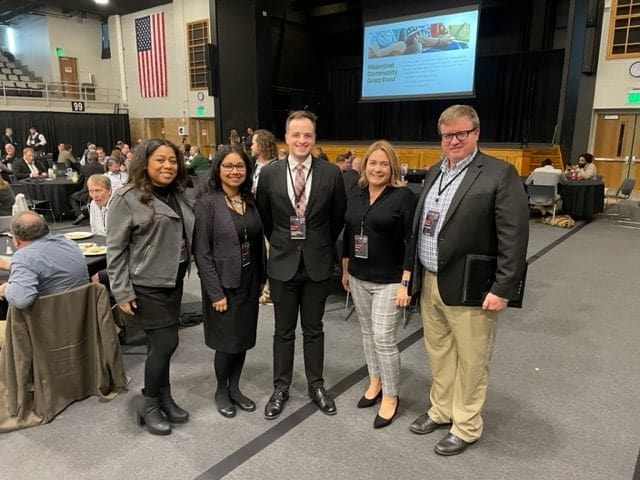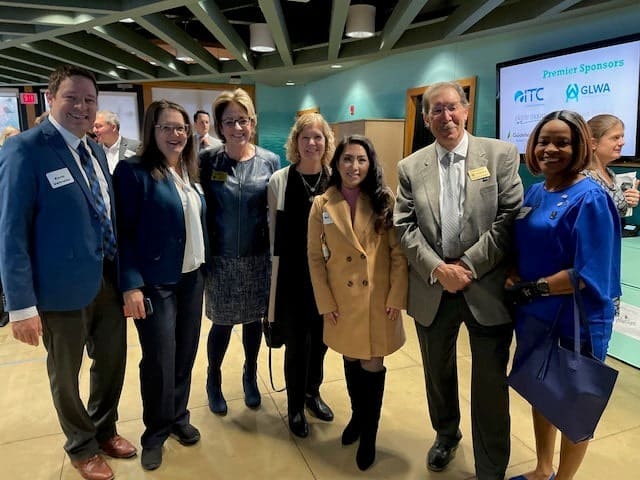This time of year, many of us are busy with familiar activities: completing annual enrollment forms for healthcare; ordering gifts from online retailers; finding ideas for holiday baking or decorations on social media; getting ready to play new games with friends, and most of all, video calling with family and friends too far to visit. Families without access to broadband at home or the means to afford the services available miss out on many opportunities during the holiday season and all year round.
Broadband – an essential utility – is the foundation for online education, remote work, telehealth, and online banking. It helps increase the efficiency and effectiveness of public safety and other public services and engagement. This is why local governments must do what they can to ensure residents, employees, libraries, and other public buildings, and businesses have access to fast, reliable, and affordable internet service.

SEMCOG joined representatives of Connect 313, MIHI, and MEDC at the Merit Broadband Summit in November
After attending events with various local governments and other stakeholders and having several conversations on the role of government in broadband, my question about broadband is: If not now, then when?
Why the time is now for local governments to lead on broadband
- Local governments are uniquely equipped to understand and respond to local needs.
- There are disparities in both availability and access to broadband within communities.
- There are currently unprecedented levels of federal and state funding for broadband infrastructure and digital literacy; it is a once-in-a-lifetime opportunity.
- We need to provide the most accurate information about unserved areas to the Federal Communications Commission (FCC) to maximize federal funding allocations for Michigan.
The Infrastructure Investment and Jobs Act provides $65 billion in broadband funding. The Broadband Equity, Access, and Deployment (BEAD) program comprises about two-thirds of the funds. Focusing on unserved and underserved locations, it “provides $42.45 billion to expand high-speed Internet access by funding planning, infrastructure deployment, and adoption programs.”
New FCC to decide funding allocations
Each state’s allocation of BEAD funds will depend on its ability to identify unserved areas by submitting data and maps to the Federal Communications Commission (FCC). The FCC recently published new maps using an updated methodology. While these provide more detailed data than previous FCC maps, they continue to overstate availability in many areas. In addition, they do not consider the affordability or reliability of services.
The National Telecommunications Information Administration will use these maps to calculate the distribution of the $42 billion of BEAD funds. Challenges to the maps must be submitted by January 13, 2023. There are two types of data and maps:
- The broadband serviceable location fabric – this shows all locations where broadband internet access service has been or could be installed.
- Fixed Broadband Availability Data – for each location, the available high-speed internet services are reported by providers.
The Michigan Office of High-Speed Internet (MIHI), is coordinating the State of Michigan’s efforts to compile data and welcomes help from local governments and the public to verify local availability. Eric Frederick, Michigan’s Chief Connectivity Officer, says:
“MIHI is developing several methodologies that we will use to identify errors and inconsistencies on the map and develop and file bulk challenges to the FCC map. Additionally, our team is encouraging consumers, communities, and any others with a stake in broadband availability to submit challenges to the FCC map if a discrepancy is found. Having an accurate federal map will ensure that Michigan receives its equitable share of federal funding to achieve universal broadband availability for all Michiganders.”
He has provided the instructions below to help local communities and consumers.
Actions for Governmental Entities
Local governments and other stakeholders can file bulk challenges for multiple locations on behalf of their communities. Governmental entities can access the underlying broadband serviceable location fabric that forms the foundation for the address locations on the map. Data can be downloaded here for various geographies by speed for comparison. He also suggests sharing the information below with residents and businesses.
Instructions for consumers on submitting a location or availability challenge
- Visit broadbandmap.fcc.gov/home, then type in an address and see if the reported coverage is accurate. You can access the site from a computer or a mobile device.
- Residents can submit a challenge by clicking Location Challenge if the location of their home or business is missing or incorrect, or Availability Challenge if the internet service information is incorrect.
- Residents should visit the website of any internet service provider that claims to serve their location and use the website’s “Check Availability” or similar tool to determine if the provider can serve their location.
- If they can’t, a screenshot of their website can be submitted to the FCC as evidence for an Availability Challenge.
Looking beyond January 13
While only verified challenges received by January 13, 2023, can be used in the allocation of state BEAD funding, local governments can continue their review in order to develop and provide additional data to the FCC after this date. This will help to both improve federal data and make communities more competitive for the BEAD grants once the State receives its allocation – expected in 2023. The more funding the State receives, the more that will be available for broadband expansion in Michigan.
Local leaders understand their communities’ needs best. While local governments may not all possess the capacity or interest to build infrastructure, there are many options available to ensure every community has the level of internet needed for its residents and businesses. These include working with existing internet service providers, electric utilities, nonprofit organizations, or anchor institutions. The SEMCOG/MAC Broadband Framework provides information on different models for broadband expansion. However, accurate data is the first step in accurately identifying the gaps that need to be filled. There is no one-size-fits-all approach for broadband. The strategy that is used depends on a community’s resources, capacity, and the scale of the need.
Amy O’Leary, SEMCOG Executive Director, spoke about the importance of broadband to county commissioners and representatives of other local communities at the Tri-County Summit on November 18, 2022.

SEMCOG’s Executive Director, Amy O’Leary, and Planning Director Kevin Vettraino with County Commissioners from Wayne, Oakland, and Macomb County at the Tri-County Summit.
SEMCOG is working to develop additional resources for communities and other stakeholders in partnership with the MIHI and our partners at the NTIA. The NTIA announced that Michigan will receive $5 million to develop a plan for its BEAD funding. The MIHI will kick off the MI Connected Future, a statewide tour of 40 cities to hear from individuals, communities, and other stakeholders. Meetings in Detroit, Warren, Pontiac, and Ann Arbor are being planned for early next year. SEMCOG will share information on these meetings with members.

Representatives from the NTIA, Wayne County Community College District, and MIHI joined Lt. Governor Garlin Gilchrist at the announcement of the BEAD planning grant on December 19, 2022.
Broadband is essential for quality of life in the 21st century, and local governments have a critical role in expanding broadband infrastructure and digital literacy throughout their communities. SEMCOG is ready to help communities navigate the journey to Internet for All.
As Joe Sawasky, President and CEO of Merit Network, a nonprofit provider of technology services to education, government, and healthcare organization in Michigan recently said:
“Broadband does not solve every problem in the 21st century but it is hard to solve any problem without it…”

Leave a Reply